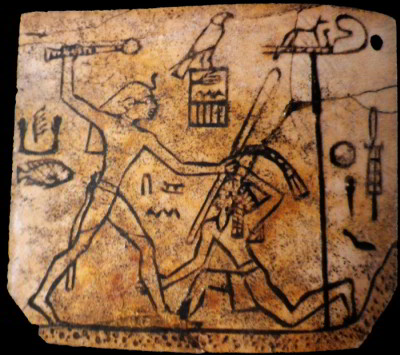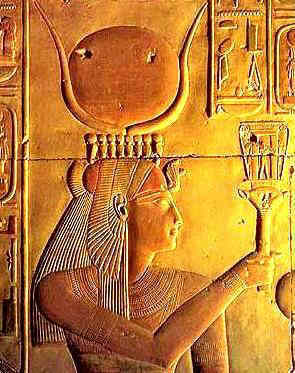 |
Pharaoh Den smiting an enemy that harks back to
the Narmer Palette courtsey of archeometry.org |
Up to this point in Egyptian history, Upper and Lower Egypt have been united under Narmer which was illustrated on the Narmer Palette, Battlefield Palette, and the Narmer Macehead. This was followed by the establishment of the capital situated at Memphis along the Nile River by Hor-Aha/Menes who succeeded Narmer. Now, let's fast forward to the 4th or 6th pharaoh called Hor-Den, Den for short. The reason he is 4th or 6th depends on the supposedly ephemeral kings of Djer, Djet and the possible queen Merneith (described in a later blog) are foggy at best. In the subsequent paragraphs, we shall explore the life of pharaoh Den and delve a little bit into the grand temple of Serabit-el Khadim located in the Sinai Peninsula.
 |
| Ruins of Serabit el Khadim courtesy of wikipedia |
Pharaoh Den began to reign roughly around the year 2900 bc and he reigned about 30 years. It is noteworthy to say that the the time period discussed, which is the Pre-dynastic Period, was from 3000-2686. This is the timeline ascribed by Ian Shaw of the University of Liverpool which will also be the timeline the author will use throughout this history. It also bears worth mentioning that the 1st and 2nd dynasties are of the Pre-dynastic Period and with the commencement of the 3rd dynasty, we will have arrived at the Old Kingdom.
 |
| Tomb of Den courtesy of internationalskeptics.com |
Getting back to Pharaoh Den though, the Egyptologist,Toby Wilkinson, says that his reign marks a milestone with the rise of Ancient Egypt. During Den's three or four decades on the throne, Den re-organised agricultural lands throughout Lower Egypt. There was just one problem however. Den's government was not especially benevolent because he seems to have removed whole communities and labelled it "crown land." Den is also credited with the organisation of the 42 nomes of Egypt thereby gaining even more effective control of the Two Lands (t3wy). Upper Egypt was not a real problem because it on traditional lines but Lower Egypt was a bit of a problem. There were not such lines to divide the Delta so Den made the template himself. It is really interesting that Upper and Lower Egypt, each, had 22 nomes with Memphis (the capital) at the heart of Egypt. All of this, of course, led to tighter and stricter control over the whole country. There was also an increase in the administration which led to the birth of more high officials. Den also allowed his court officials to build mastabas or mud brick tombs. What is interesting about these tombs, however, is that they were modelled after White Wall at Memphis was an imposing façade in its own right. One such official, Hemaka, was buried in one such mastaba who was chancellor of the treasury.
 |
The goddess Hathor courtsey
of landofthepyramids.org |
This however does not compare with his crowning achievement, the great temple of Serabit el Khadim. According to the Historical Dictionary of Ancient Egyptian Warfare, there is evidence that Pharaoh Den was active in the Sinai Peninsula. There is even evidence of military action in the reign of Khasekhemwy of the 2nd dynasty. The above picture of Den smiting an enemy is actually from this region where the temple was built. There is also evidence of other pharaohs sending expeditions to the area in order to construct their own tombs as well. Mentuhotep II, for example, of the 11th dynasty, sent an expedition to the area after his reunification of Egypt. Initially, The temple is dedicated to the goddess Hathor. The reader may remember that Hathor was the goddess who 'consumed' the attributes of the bovine goddess Bat of the 7th nome in Egypt. It is also interesting that Den sent mining expeditions in that region not just for tin and copper (which together make bronze) but for turquoise as well. Unfortunately, there isn't much use for turquoise except that it is a beautiful stone usually worn by the elite in Egypt. In addition to its great worth to the elite, it is also associated with the goddess Hathor.
In conclusion, Pharaoh Den had a great impact on Ancient Egypt that can still be seen to-day.He organised Egypt into 42 nomes, re-organised agricultural lands in the Delta, and successfully built his tomb which is still in tact to this day. His achievement of the Temple to Hathor in Serabit el Khadem, in the Sinai, is a testament to his long, successful reign.
References
Morkot, Robert. January, 2003. Historical Dictionary of Ancient Egyptian Warfare.
Wilkinson, Toby. January, 2013. The Rise and Fall of Ancient Egypt.



No comments:
Post a Comment